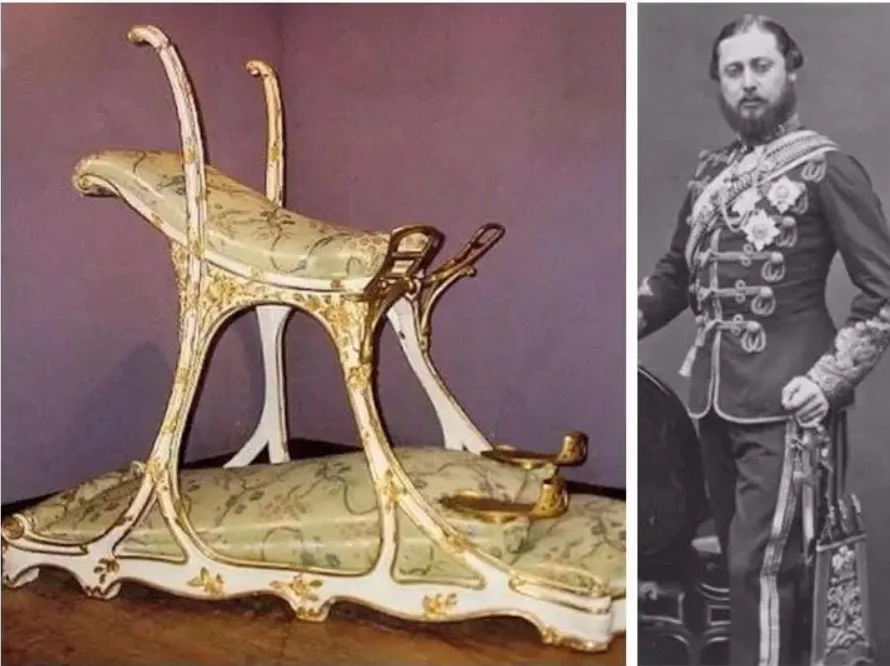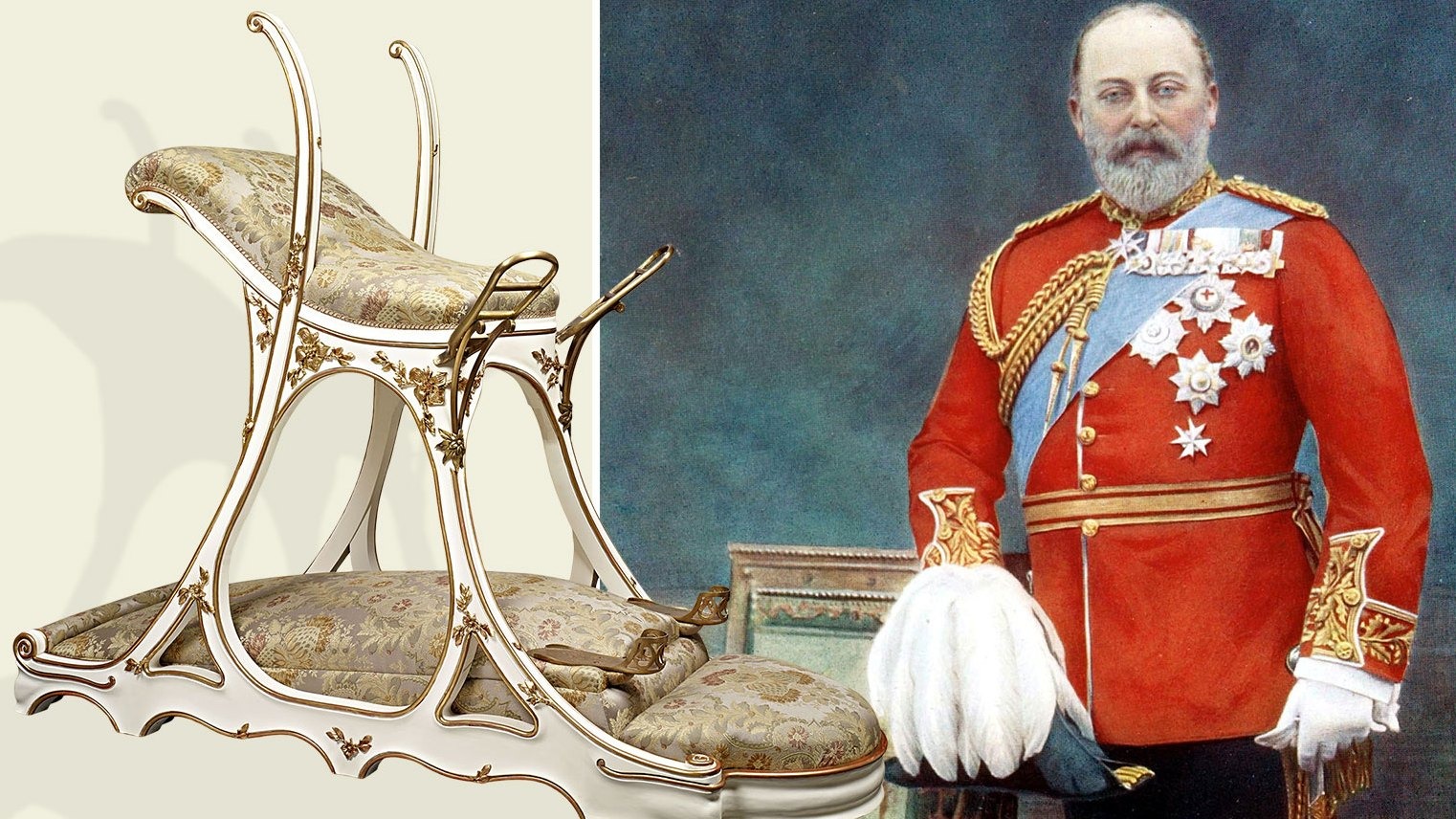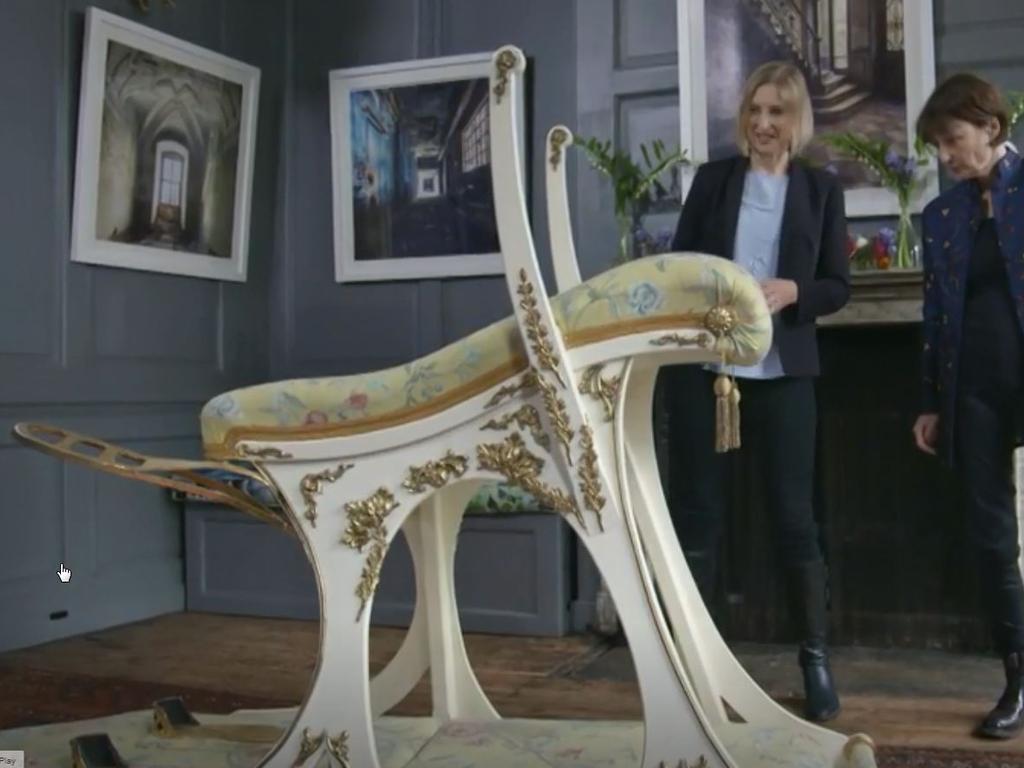Among the colorful monarchs of British history, King Edward VII (1841–1910) occupies a unique place. Known during his youth as the playboy Prince of Wales and later crowned king in 1901, Edward cultivated a reputation for indulgence, diplomacy, and modernity. While his reign lasted only nine years, his personal life—marked by extravagance and controversies—remains a source of fascination.
One of the most unusual artifacts associated with Edward is the so-called siège d’amour or “love chair.” Crafted in the late 19th century by Parisian furniture maker Louis Soubrier, the chair was designed to accommodate Edward’s corpulent frame while allowing him to indulge his social and private lifestyle. Although originally created for use in Paris’s elite entertainment venues, it has since become a historical curiosity, sparking debates about royal excess, cultural decadence, and the interplay between private behavior and public reputation.
Today, replicas of the chair appear in museums, antique collections, and even international exhibitions. Beyond its scandalous reputation, the artifact reflects a blend of Victorian contradictions—prudish public morals in Britain versus exuberant freedoms in Paris—and illustrates how design, engineering, and art can intersect with history in unexpected ways.
Edward VII: The Playboy Prince Turned King

Edward VII was the eldest son of Queen Victoria and Prince Albert. From an early age, he clashed with his parents’ strict moral expectations. While Victoria and Albert valued discipline and duty, young “Bertie,” as he was called within the family, gravitated toward luxury, fashion, and sociability.
As Prince of Wales, Edward developed a reputation for his extravagant lifestyle, attending lavish banquets, traveling widely across Europe, and maintaining a circle of aristocratic and artistic acquaintances. French newspapers often described him as a connoisseur of fine dining and high society. He became known for his charisma, humor, and ease in social settings—traits that later helped him modernize the monarchy by connecting with broader audiences.
But his fondness for indulgence also invited criticism. Stories of his gambling, affairs, and extravagant tastes circulated both in London and abroad. These tales contributed to his nickname, “Edward the Caresser,” and set the stage for the legend of the “love chair.”
Paris at the Fin de Siècle: Le Chabanais and the Belle Époque

The chair’s story cannot be separated from the cultural context of fin-de-siècle Paris, a city then at the height of its Belle Époque. Paris was celebrated for its art, fashion, and architecture, but it was also known for venues of luxury entertainment that attracted wealthy travelers from across Europe.
One such venue was Le Chabanais, a high-end establishment catering to aristocrats, artists, and foreign dignitaries. It was famed for its themed rooms—such as the Hindu Chamber and Moorish Salon—decorated by leading artisans of the era. For elites like Edward, these spaces offered a retreat from the constraints of public life in Britain.
It was in this environment of opulence and permissiveness that Louis Soubrier, a respected French cabinetmaker, is believed to have crafted the unique “love chair.” Unlike traditional seating, this bespoke design combined artistry, luxury materials, and practical engineering tailored to Edward’s physical needs.
The Ingenious Design of the “Love Chair”

Although myths and speculation have surrounded the chair’s function, its construction demonstrates remarkable craftsmanship. Made around 1890, the chair blended the form of a chaise longue with custom supports and padded sections. Bronze detailing and rich upholstery reflected the decorative tastes of late-19th-century Paris, where even utilitarian furniture could be elevated to art.
What made the chair remarkable was its structural innovation. Edward, known for his large waistline—reportedly up to 48 inches—required furniture sturdy enough to support him comfortably. The chair’s reinforced frame, strong footrests, and carefully angled supports reveal the attention to both aesthetics and mechanics.
While its precise usage has been sensationalized, historians agree that the chair embodied the intersection of engineering ingenuity and aristocratic excess. It demonstrates how furniture could be designed not only for function but also to cater to the unique preferences of elite clients.
From Private Object to Public Curiosity

After Edward’s death in 1910, the chair remained associated with Le Chabanais and was preserved by the Soubrier family. Over the decades, its notoriety grew, partly because it symbolized the double standards of Edwardian society: Britain under Queen Victoria was famed for strict morality, yet her heir openly embraced a more permissive lifestyle abroad.
The chair resurfaced in public exhibitions, most notably at the Musée d’Orsay in Paris (2015–2016) during the exhibition Splendour and Misery: Images of Prostitution 1850–1910. Displayed alongside artworks and artifacts from the same era, it was presented less as an object of scandal than as a cultural artifact reflecting the complexities of gender, class, and leisure in late-19th-century Europe.
Replica versions of the chair are today displayed in institutions such as the Sex Machines Museum in Prague and at M.S. Rau Antiques in New Orleans, where it was offered for sale at nearly $70,000. These exhibitions highlight not only public curiosity but also ongoing debates about how museums should present artifacts linked to taboo or controversial subjects.
Cultural Significance: Decadence, Power, and Contradiction
The love chair tells us as much about society as it does about Edward VII himself. It represents:
-
Contradictions of the Victorian era: While Britain preached strict moral codes, many elites indulged privately in behaviors they would never acknowledge publicly.
-
The intersection of power and indulgence: Edward’s wealth and position allowed him to commission bespoke luxuries that ordinary citizens could scarcely imagine.
-
Artistry and scandal intertwined: The craftsmanship of Soubrier elevates the chair beyond mere gossip; it is an object of design history as well as cultural controversy.
-
A reflection of Belle Époque Paris: The city’s reputation as both a center of art and indulgence provided fertile ground for the creation of such unusual furniture.
Edward VII’s Broader Legacy
Although remembered for his flamboyant lifestyle, Edward VII was also a monarch who contributed to shaping modern Britain. His reign, though short, saw:
-
The strengthening of diplomatic relations with France, laying groundwork for the Entente Cordiale.
-
Innovations in royal ceremonial life, including his role in modernizing coronations and public pageantry.
-
Support for fashion, architecture, and the arts, which earned him respect as a cultural patron.
The “love chair,” while symbolic of his excesses, is only one part of his multifaceted legacy. It reflects the private indulgences of a man who, in public, helped reorient the monarchy toward a new century.
Modern Interpretations and Debates
Today, discussions about the chair extend beyond its titillating reputation. Scholars and commentators consider:
-
Ethical perspectives: Should such artifacts be celebrated, critiqued, or contextualized carefully within exhibitions?
-
Historical reflection: What does the chair tell us about gender dynamics, privilege, and the contrast between public morality and private indulgence?
-
Popular fascination: Social media discussions and documentaries—such as Channel 4’s A History of Royal Scandals—demonstrate that Edward’s lifestyle continues to intrigue modern audiences.
These debates underline the evolving role of museums and media in interpreting controversial heritage. Rather than glamorizing the object, many curators emphasize it as a lens through which to explore historical attitudes toward pleasure, excess, and power.
Conclusion
The story of King Edward VII’s “love chair” is far more than a royal curiosity. It is a reminder of the contradictions of an age when public morality and private indulgence existed side by side. Crafted by master artisan Louis Soubrier for use in Paris’s most exclusive venues, the chair embodies the extravagance of Belle Époque culture and the larger-than-life persona of Edward VII.
Today, whether displayed in museums or debated in media, the chair continues to spark conversations about the intersection of design, decadence, and history. It illustrates how objects once created for private luxury can, over time, become cultural artifacts with enduring power to challenge, intrigue, and inform.
King Edward VII may be remembered for diplomacy, modernization, and the dawn of a new royal era, but the “love chair” remains a provocative reminder of his flamboyant character and of the broader cultural dynamics of his time. In that sense, it is not just a scandalous relic—it is a piece of history that forces us to confront the complexities of power, privilege, and personal desire in the making of modern monarchy.
Sources
-
BBC History – Edward VII: The Playboy Prince Who Became King
-
[Musée d’Orsay – Splendour and Misery: Images of Prostitution 1850–1910 Exhibition Notes]
-
Catharine Arnold, Edward VII: The Prince of Wales and the Women He Loved (HarperCollins, 2002)

